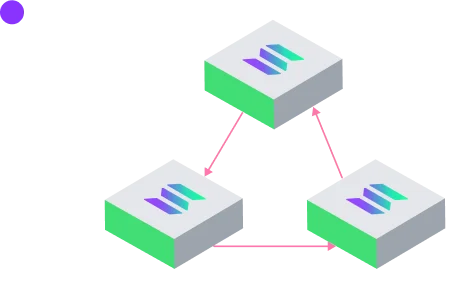Solana Tutorial
60 Days of Solana
This Solana course is designed for engineers with a beginner or intermediate background in Ethereum or EVM development to get up to speed quickly with Solana program development.
Skip to ContentsThe difficulty engineers face when learning blockchain programming for the first time is they have to learn a new computation model, learn a new language, and learn a new development framework.
If you have already developed on an Ethereum or Ethereum compatible blockchain, you already have a pretty good idea of the computation model and can focus on the language and the framework instead.
Our goal is to leverage your past experience with Ethereum to learn Solana faster.
It is not necessary for you to start from zero.
Solana has a different model of how to run a blockchain than Ethereum does, but not too different.
Rather than jump into explaining all the differences, this tutorial attempts to compress key information into the following paradigm:

“I know how to do X in Ethereum, how do I do X in Solana?
And under certain circumstances,

“I cannot do X in Solana, why is that?”
We’re taking this approach because it’s far easier to develop a mental model for something new if you are able to map over concepts from a mental model you already have.
If you’re like most programmers, Solidity was probably easy to learn for you. It’s nearly one-to-one with JavaScript. However, designing smart contracts was probably a challenge because it’s quite unlike other applications.
We want you to come away with an understanding of how Solana and Ethereum are similar, as well as the key ways in which they differ.
(Note: We talk about Ethereum often throughout this series, but all the ideas are applicable for other EVM-compatible blockchains, such as Avalanche and Polygon).
All blockchains are decentralized state machines

It is a distributed state machine that undergoes transitions based on signed transactions where the cost of execution is paid in the ecosystem’s native token (ETH for Ethereum, and SOL for Solana).

Our goal is to leverage your EVM knowledge as a springboard for your Solana development journey.
Consider This Analogy
If a frontend web developer and a backend API/Database engineer both decided to learn mobile app development, most engineers would say the frontend web developer has a massive head start over the backend engineer, even though web development and mobile development are not the same field even if the dev experiences can be very similar with some toolchains.
Using that line of reasoning, we at RareSkills believe that a competent EVM smart contract engineer should be able to pick up Solana faster than an engineer who hasn’t programmed a blockchain before.
This course is designed to lean into that advantage.
We start with the aspects of Solana that are similar to Ethereum
Start with the EVM's equivalent in Solana
Ease your transition with bite-sized exercises
An active learning journey
We expect you’re familiar with Solidity
How much Rust should I know?
Not a lot.
Rust is a huge language with enough syntax to dwarf most other popular languages. It would be a mistake to “get good at Rust first” before learning Solana. You might be on a detour that could last several months!
This course focuses only on the minimum Rust you need to know.
If you feel uncomfortable diving into a language you haven’t used before, complete the free videos and exercises in our Rust Bootcamp and leave it at that. Our reviewers have completed the exercises here without going through the Rust Bootcamp first, so we think we’ve successfully balanced teaching just the right amount of Rust in this course.
Why 60 days?
We have found learners stay most engaged when information is broken down into the most atomic bits possible. If tutorials are too long, only the most interested readers will complete them. After constraining the tutorials to be as atomic as possible, we estimate that about sixty of them are necessary to have a comfortable grasp of the Solana development ecosystem.
We have beta tested these tutorials and find that the reviewers are able to comfortably complete them in less than an hour. Not having to expend too much effort each day makes studying Solana more sustainable and reduces the likelihood of burnout.
Motivated readers can complete the course a lot faster if desired.
Readers who are only casually interested in Solana can consume the course at a more leisurely pace without expending too much valuable time and energy on any given day.
Our course is designed so that you can quickly refer to something you need when programming an application. For example, if you forgot how to get the current time in Solana, you’ll easily be able to jump to the appropriate section and copy and paste the code you need.
Please note that the code in this article is MIT licensed, but copying, duplicating, or creating derivative works of this course without permission is strictly prohibited.
Acknowledgements
Good Luck, and welcome to Solana!
Solana Course
Introductory Topics
The minimum Rust you need to know
Day 8-10 are not critical, they only explain some syntax which is likely unfamiliar to most readers. However, you can write Solana programs and follow along while treating the unusual syntax as boilerplate. Feel free to skim over those days.
Important System-level Information in Solana
Accounts and Storage in Solana
Accounts are one of the most complicated topics in Solana development because they are considerably more flexible than Ethereum storage variables., so we go over them slowly. Each tutorial will progressively reinforce concepts, so don’t worry if all the new information doesn’t stick right away.
Tokens on Solana
This module describes how tokens, especially SPL tokens and Token-2022 work in detail.
Advanced Topics in Solana Development
This module explores more advanced design patterns and low-level topics.